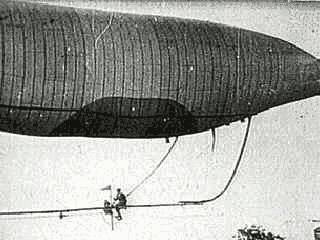Today, we talk about powered flight and the Gold Rush. The University of Houston's College of Engineering presents this series about the machines that make our civilization run, and the people whose ingenuity created them.
The people who went west and the people who first tried to fly were cut from the same bolt of cloth. They were brash and imaginative. It's no surprise that America's first steps toward powered flight are tied to the California Gold Rush.
When gold was discovered, a man named Rufus Porter promptly tried to start air service between New York and California. He sold tickets and then tried to build a huge airship with the profits. He failed, of course. But a few years later Frederick Marriott had the same general idea with a much better plan.
Marriott was an English newspaperman. He was both a partner and a publicist for an unsuccessful airplane in the 1840s. In fact, it was Marriott who first coined the word "aeroplane."
In 1848 he boarded a ship for the California Gold Fields. Maybe his dreams of flight would fare better in our new land. Marriott settled in as a banker and newspaperman in San Francisco. He was one of Mark Twain's early publishers. By 1866 he was solid enough to form a group called the Aerial Steam Navigation Company. Its aim was to create a steam-powered airship line between New York and San Francisco. Only one airship had flown by then -- a little one-man dirigible in Paris, 14 years before.
Marriott didn't try everything in one bite. First he made a 37-foot unmanned dirigible -- a big football fitted with control surfaces. Its two propellers were driven by a beautiful little alcohol-powered steam engine only a foot long. He called it the Hermes Jr. Avitor. He planned to follow it with the Hermes Avitor -- a 150-foot manned airship.
He flew his Avitor over and over during the summer of 1869. A ground crew would run after it setting its controls with a rope. It was a clear success, and Marriott rhapsodized over it: "No savages in war paint," he said,
shall interrupt its passage ... across our continent. No malaria, or hostile tribes nor desert sands shall prevent the exploration of Africa. ... Man rises superior to his accidents when for his inventive genius he ceases to crawl upon the earth and masters the realms of the upper air.
Marriott was ready to build the large manned version when disaster struck his company in the form of the 1870 stock-market crash. By the time he died in 1884, he'd bounced back. He was then trying to build an aeroplane. By then, a little hand-cranked airship had finally flown in America.
Perhaps Porter and Marriott were three parts showman to one part engineer. But we stop laughing when we look at the first successful dirigibles. By 1900 machines of the same size and shape were doing just what they'd claimed was possible.
I'm John Lienhard, at the University of Houston, where we're interested in the way inventive minds work.
(Theme music)
Kurtz, G.F., 'Navigating the Upper Strata' and the Quest for Dirigibility. California History, Vol. LVIII, No. 4, Winter 1978/9, pp. 334-347.
Crouch, T.D., The Eagle Aloft. Washington D.C.: Smithsonian Institution Press, 1983, Chapter 11.
For more on early dirigibles and California, see Episodes 188, 331, 349, and 1308.

(clipart)
An unidentified photo of an early dirigible -- not much later than Marriott's